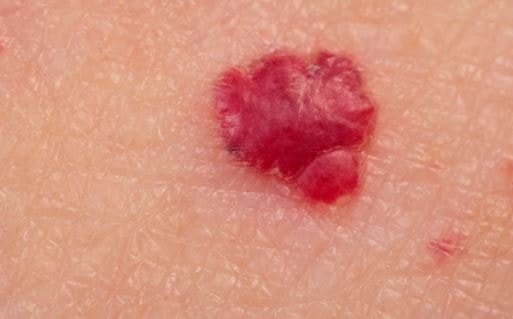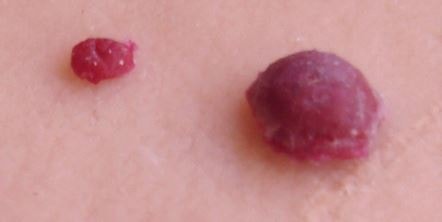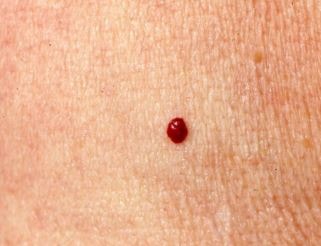What is Cherry Angioma?
Cherry angiomas which is also referred to as Campbell de Morgan spots or senile angiomas, are vascular lesions that can usually grow on the human skin. These growths are made up of dilated capillaries that are grouped together which is why the lesions appear cherry or purple-red color.

The growths may occur on most areas of the body, but is commonly found on the torso and sometimes develop on the hands or feet. When the growths begin to occur, they will first more or less look like the size of a pinhead without protruding above the surface of the skin. Even so, some of these growths can increase in size up to 1/4 inch or more across and may turn spongy, dome, or mushroom shaped.
These growths do not cause any harm or pain, although many people want to get rid of them for cosmetic reasons. Big angiomas might bleed if they are injured. This is why people should not prick or remove them alone. Cherry angiomas can grow anytime in life, and it usually develops after the age of 40. These cherry bumps can grow alone or in clusters.
What Causes Cherry Angioma?
There is only little amount of information gathered of what causes cherry angiomas, though it is still not very clear of what factors really add to the formation of the growths.
Some people also acquire cherry angiomas by genetic factors and have been associated with climate, dehydrated skin, pregnancy, and laying open to chemicals. In tremendously rare occasions, the growths can arise because of a developing internal malignancy that had already been present.
Some reports have describe several red tiny lesions to be similar in people with malignancies, but often these lesions happen in healthy individuals. Stress can also be a factor in causing cherry angiomas and if the person experiences an ongoing stress, this might lead to the occurrence of cherry angioma.
It has been proven that a stressed individual will tend to age faster and the older the person gets, the greater is the factor of having cherry angiomas. Also, the growths get bigger in number and size with age. 70% of people manifesting multiple angiomas are 7o years old and above.
What are the Symptoms of Cherry Angiomas?
Cherry angiomas normally begin as red dots and usually the size of a pinhead, but can grow up to 1/4 an inch size. Other symptoms of these lesions on the skin are bright cherry-red growths that are smooth and mostly appear on the legs, arms, and other parts of the body. Somehow they tend to protrude a little and look as tiny red-bumps.
How to get rid of Cherry Angiomas?
Frequently, cherry angiomas cause little health concern since it is not even cancerous and no pains are caused by the growth, which is why these lesions can be treated at home. Nevertheless, if pain is felt, bleeding occurs, or the angiomas appearance starts to change, a physician should be consulted. Otherwise, home remedies include:
Apple Cider Vinegar – It is a natural substance taken from fermented apples and has many healing properties. When ACV is applied to cherry angiomas, the growths will shrink, changes in color, and goes away in a matter of time.
Iodine – In order to use this as a treatment for cherry angiomas, Iodine consumption should be increased daily in order to get rid of body toxins and get rid of the growths.
Tea Tree Oil – According to researchers, tea tree oil has a potent antibacterial agent. The oil can dry out and extinguish angiomas.
Medical Treatment for Cherry Angiomas
Treatments might not be necessary, but if it has to be removed for cosmetic reasons or that it is on the area of the skin where it can be bumped and may lead to other consequences. The person can consult a physician or any skin specialist since the condition might mean some serious conditions like skin cancer.
The physician may possibly decide to do a biopsy, which includes some examination and the removal of a small sample of the angioma in order for it to be diagnosed or rule out other severe conditions.
These are the different approaches in removing cherry angiomas:
Cryosurgery – This is an easy and quick type of treatment which requires freezing the angioma with liquid nitrogen, and the maximal cold will terminate the growths.
Electrocauterization – This is a surgical procedure that necessitates burning the angiomas with the use of electric current supplied by a tiny probe. A grounding pad is also used to protect the rest of the body from the electricity.
Shave Excision – This treatment involves slicing away at the growths in thin layer until it is completely gone and using stitches to close the wound.
Laser Surgery – This type of treatment is done quickly and requires the use of a pulsed dye laser (PDL) to remove cherry angiomas. The pulsed dye laser is a yellow laser that gives off heat to terminate the growths. The treatment sessions will also depend on the number of angiomas present and the surgery may cause minor lesions which can last up to 10 days.
Images



References:
Cherry Angioma Prognosis, Treatment at http://www.md-health.com/Cherry-Angioma.html
Cherry Angioma – Overview Appearance, Causes, Medical Treatment, Prognosis at http://www.healthline.com/health/cherry-angioma#Treatment5
Emadi, Seyed Naser; Hosseini-Khalili, Alireza; Soroush, Mohammad Reza; Davoodi, Seyed Masoud; Aghamiri, Seyed Samad (2008). “Mustard gas scarring with specific pigmentary, trophic and vascular charactristics (case report, 16-year post-exposure)”. Ecotoxicology and Environmental Safety 69 (3): 574–6.
James, William; Berger, Timothy; Elston, Dirk (2006). Andrews’ Diseases of the Skin: Clinical Dermatology (10th ed.). Philadelphia: Saunders. p. 595.
Hefazi, Mehrdad; Maleki, Masoud; Mahmoudi, Mahmoud; Tabatabaee, Abbas; Balali-Mood, Mahdi (2006). “Delayed complications of sulfur mustard poisoning in the skin and the immune system of Iranian veterans 16–20 years after exposure”. International Journal of Dermatology 45 (9): 1025–31.
